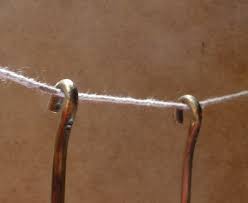 by: Martin Sagendorf
by: Martin Sagendorf
One Pendulum…
Is interesting, but…
Two Pendulums…
Are much more interesting.
But only if they are coupled pendulums.
An Easy Way Is To…
Couple them at their pivot points. This is accomplished by hanging the two pendulums from a horizontal string.
There Are…
Many illustrations of coupled pendulums on the web; search for ‘coupled pendulums’ – but the fine points of making a really successful demo are rarely discussed… so before we start:
Some Guidelines:
– Make the pendulums absolutely identical: both the rod lengths and the mass values (the lengths are measured from the pivot points to the C.G. of the masses)
– Use rod lengths of at least 1/3 meter (13”) – so the pendulums don’t swing too quickly
– Use masses of at least 75 g (1 oz) – to provide a long swing time
– Space the vertical supports for a horizontal string length of 500 to 600 mm (20 to 24 in.) – weighted or clamped-down ring stands will work – and will work especially well if their top ends are joined by a solid bar to minimize vibrations
– The string should be fairly taunt – for example: a 13 to 15 mm (1/2 to 5/8 in.) droop in the center with two 75 g masses hanging 100 mm (4 in.) apart
– Use pendulum spacings of 75 to 125 mm (3 to 5 in.) – experiment for good results
– For the best results, symmetrical setup spacing is critical – try to achieve positions symmetric within 4 mm (1/8 in.)
– When pulling a pendulum to the side, two things are very important: first, don’t pull it too far (a mass rise of 75 mm (3 in.) is fine); second, the pendulum must be pulled at precisely a right-angle to the string
– For the following exercises, when two pendulums are raised, they should be raised to the same heights
With Two Identical Pendulums:
Center the two pendulums with the pair spaced about 100 mm (4 in.) apart
– (A.) Raise and release one pendulum
Question: What happens? Why?
– (B.) Raise (on opposite sides) and release both pendulums
Question: What happens? Why?
With Three Identical Pendulums:
Center the three with a space of about 75 mm (3 in.) between each
– (C.) Raise and release the center pendulum
Question: What happens? Why?
– (D.) Raise and release one of the outer pendulums
Question: What happens? Why?
– (E.) Raise (on the same side) and release both outer pendulums
Question: What happens? Why?
– (F.) Raise (on opposite sides) and release both outer pendulums
Question: What happens? Why?
So Far…
We have dealt with identical pendulums… but what happens if we:
– (G.) Make a pendulum with a greater mass (but the same length) and use it in place of one of those above.
Question: What happens? Why?
– (H.) Make a pendulum just slightly longer (say, 20%) than one of the three and use it in place of one of the pendulums above.
Questions: What happens? Why?
In Action:
Construction Notes:
– The horizontal string must be firmly attached (tied, hooked, or taped) to the vertical rods
– The pendulum rods are made from coat hanger wire or from welding rod
– Hooks are formed in the pendulum rods using a pair of pliers
– The masses can be any object that can be affixed to the rod – preferably an object through which a hole can be drilled and, for easy identification during demonstrations, the masses should be different colors
In This Apparatus:
– Length of horizontal string = 600 mm (23-1/2”)
– Length of pendulum rods (from inside hook to far end) = 440 mm (17-7/16”)
– Diameter and material of pendulum rods = 1/8” brass welding rod
– Thread on end of pendulum rod = 6-32 for a length of ¾ in. (Note 1)
– Nuts = brass 6-32 knurled (2 per rod)
– Small mass = 5/8” x 2-1/16” steel rod (75 g) – 3 required (Note 2)
– Large mass = 1” x 1-3/4” steel rod (175 g) – 1 required (Note 2)
– Distance from inside of pendulum rod hooks to the centers of masses = 400 mm (15-7/8”)
Note 1: A No. 6 screw diameter is 0.138”. – the 1/8 in. welding rod is 0.013” less – this is OK
Note 2: Drilled thru No. 29 (0.136”)
A Comment on Dimensions:
The overall dimensions are not critical, but the apparatus should be large enough to be easily viewed in a classroom setting.
A Definition:
These are ‘Simple Pendulums’ because they are not ‘ideal’: i.e. their masses are not concentrated at single points and the restoring force is not a constant – however they do exhibit ‘Simple Harmonic Motion’. This motion is an approximation at small angles – it is sufficiently accurate for our purposes.
And Further:
The details of Harmonic Motion and Simple Harmonic Motion are fascinating – the details of both can be found in any physics textbook.
‘Resonance’ is defined as the building up of large vibrations by the repeated application of small impulses whose frequency equals one of the natural frequencies of the body – in this case, a pendulum. Identical pendulums are required to provide maximum energy transfer. The mechanical energy is transferred by the ‘pulls’ on the supporting string – this is rather like a child’s swing where ‘pushes’ applied at the correct times will ‘add’ and act to increase the swing amplitude.
In Summary:
These demonstrations provide vivid illustrations of energy transfer between two and three resonant bodies. Even better, additional pendulums, various masses, and variations of excitation will provide more interesting demonstrations and bases for experimentation.
Marty Sagendorf is a retired physicist and teacher; he is a firm believer in the value of hands-on experiences when learning physics. He authored the book Physics Demonstration Apparatus. This amazing book is available from Educational Innovations, Inc. – it includes ideas and construction details for the creation and use of a wide spectrum of awe-inspiring physics demonstrations and laboratory equipment. Included are 49 detailed sections describing hands-on apparatus illustrating mechanical, electrical, acoustical, thermal, optical, gravitational, and magnetic topics. This book also includes sections on tips and hints, materials sources, and reproducible labels.


Thank you. I’m anxious to try this out.
Connie
Enjoy! Let us know how you make out!
Harmonic motion is one of my favorite topics and I’ve found that coupled pendulums are a great way to let kids experiment and explore the idea of resonance as part of harmonic motion. However, since I work with 7th graders, we’ve kept our examples a little bit simpler than this one. Instead of using the metal bars or wire attached to the weights, we use string for that portion also. When I first show this, I have the support string tied up but no pendulums hanging down. I’ll then ask one of the kids to take off their sneakers and then tie one of the laces from each sneaker to the support string, wide enough apart so that they do not collide. What will happen if we pull one of the sneakers back and release it? Air out the sneaker, make the room smell bad are suggested, I then release it and it works surprisingly well with one sneaker swinging and then alternating to the other. At this point someone usually asks what is happening. I might throw out a silly answer like: when you walk, the shoes get used to alternating in their movement so perhaps that’s what they are doing now.. After the groans subside, I then suggest this is something we can explore as a lab activity. To do so, we can use heavy steel nuts, metal washers, or sinkers to replace the shoes. What are all the variable that we can change? Suggestions include: 1. change the tightness of the support string 2. make both pendulums heavier or lighter 3. make one heavier than the other, 4. pull them both back together 5. add 2,3,4 more pendulums of the same length 6. make 5 pendulums to the same string all with different different lengths add a 6th pendulum that is the same length of one of the others (barton’s pendulum) 7. change the distance between the pendulums, 8. support string longer or shorter. Kids break down into groups and test a few ideas and make observations. After it’s all done we discuss what we found and try to draw up conclusions. So what is going on? Resonance is when the energy exchanges places and accumulates from one place to another ? Why? It begins with both pendulums having the same length and thus having the same matching frequency. Every time the first pendulum swings, the connecting string gives the second pendulum a small tug making it swing also. Since the second pendulum has the same frequency as the first, the tug occurs in a position that adds to the movement of the second pendulum. The easiest way for kids to relate to this is think about a swing set and ask how does that work? Either someone pushes or the act of swinging the legs add energy to the system and you end up with a very large amplitude. One final note. I’ve used all sorts of bobs for this, apples, bananas, bowling balls, and finally up to using two same size students. Our school had two posts that we could tie rope between. At the bottom of each pendulum rope, I added a one foot section of 2×4 with a hole drilled through it and tied it to the rope, this gives the kids something to sit on. The idea of resonance stretches across the entire range of science studies as in chemistry, atomic structure, sound, electricity and the coupled pendulum may well be the perfect way of introducing it.
Another variation of the coupled pendulum is one that is a combination of two pendulums that are connected vertically.
A common set up might be 18 inches of string then a brass weight.
To the bottom of this pendulum tie another 18 inches of string and then a much smaller brass weight. I might suggest the first weight be 10 times heavier than the second weight. pull the bottom weight back and release it. Once again you will see the energy flow from one area to another as the pendulums alternate in their movements. For a bit of fun the weights can be all sorts of objects.
For example, I might pull an apple and a strawberry or a couple of cherries out of my lunch bag, the string goes through the apple and then tied to the berry stem. Another cool example is my room has fluorescent lights that hang down from the ceiling that I hang my earth globe on, it also exhibits the resonance of coupled pendulums. The hotel that hosts our state science convention has excellent chandeliers that I can tie my sneaker to and it will show the same concept. The point is, look around, experiment and ask the kids to come up with their own ideas, you will be amazed at what they will try.